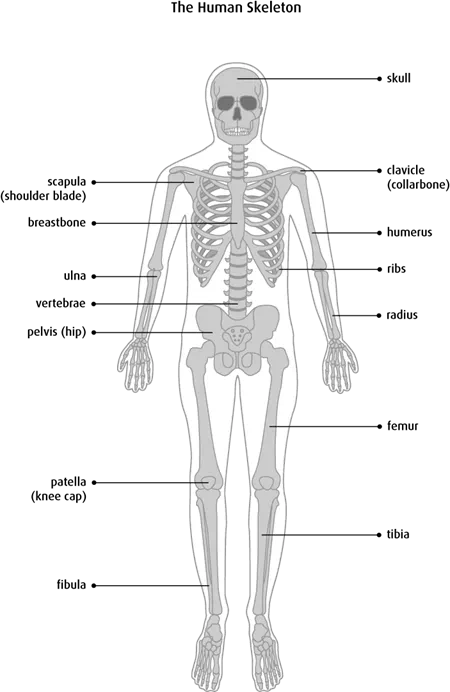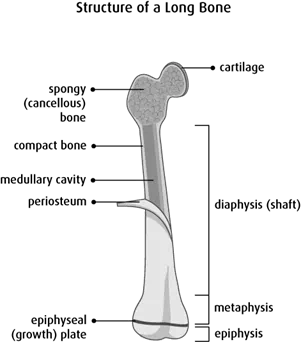The bones
Bone is a strong and stiff connective tissue made up of minerals and collagen. Bones carry out many important functions in the body, including:
- supporting the body’s tissues
- protecting important organs, such as the heart, lungs and brain
- working with muscles, tendons and ligaments to allow the body to move
- storing fat and minerals
- releasing minerals, such as calcium, phosphorus and magnesium, when the body needs them
- making blood and immune cells in the red bone marrow of some bones
Groups of bones and cartilage form the skeleton, which gives shape and form to the human body. The adult human skeleton is made up of 206 bones.

Types of bone
Bones may be classified based on their shape.
Long bones are long and thin. They are mostly made up of compact bone, which is dense, hard and smooth. Examples of long bones are the femur and humerus. Bone cancer is more likely to start in the long bones of the body.
Short bones are often smaller cube-shaped bones. They contain mostly spongy bone. Examples of short bones include wrist and ankle bones.
Flat bones are thin, flat and often curved. They are made up of 2 thin layers of compact bone with a layer of spongy bone between them. Examples of flat bones are the ribs and the breastbone.
Irregular bones have complex shapes and can’t be classified into the above categories. Examples of irregular bones include the pelvis (hip) and the vertebrae (spine).
Bone cells
There are 3 types of cells that make up bones:
- Osteoblasts build new bone.
- Osteoclasts dissolve and remove old bone.
- Osteocytes maintain bone. These cells carry nutrients from the blood to the bone and remove waste products from inside the bone.
Bone is very active tissue. Bone tissue is constantly being replaced by new bone tissue (remodelled). Osteoblasts are building new bone while osteoclasts are removing old bone. When osteoblasts work faster than osteoclasts, bone gets bigger and stronger. Bone can also be remodelled and heal after an injury. Along with bone cells, some hormones and minerals help bones remodel and heal.
Bones can get stronger or weaker in response to changes in the body, such as the blood’s calcium levels. Bones can also adapt to changes in the muscle. For example, when muscles get stronger from lifting weights, bones also get stronger. Bones naturally get weaker and less dense as a person gets older.
Structure
Bone is one of the hardest materials in the body. It is made of collagen and minerals, such as calcium, that make it strong and hard. Although bones differ in shape and size, they all have basically the same structure and function.
Bone is made up of different layers of materials. Several terms are used to describe features of bones throughout the body.
Periosteum
The periosteum is a thin layer of fibrous tissue that covers the outer surface of the bone, except at the ends.
Compact bone
Compact bone is dense, hard and smooth. It forms the outer layer (or wall) of a bone. Compact bone surrounds spongy bone and yellow bone marrow in the shaft of the bone. Compact bone is also called cortical bone.
Compact bone has many canals (passageways) that contain blood vessels and nerves. Blood vessels carry the blood to bone cells. The blood brings oxygen and nutrients to the bone cells. It also takes away carbon dioxide and waste products. Nerves are in the bone and around the bone.
Spongy bone
Spongy (cancellous or trabecular) bone is very porous with lots of open space within it, sort of like a honeycomb. It surrounds the medullary cavity.
Spongy bone stores red bone marrow, which is where blood and immune cells are made. In an adult, red bone marrow is found mainly in the spongy bone in the skull, breastbone, ribs, pelvis, collarbone and vertebrae.
Medullary cavity
The medullary cavity is the space inside the shaft that contains yellow bone marrow. The yellow bone marrow mainly stores fatty tissue.
Cartilage
Cartilage covers each end of a bone. It is a tough, fibrous connective tissue mixed with a gel-like substance. It is softer than bone, but firmer than most tissues. Cartilage stops the bones from rubbing together and acts like a cushion to absorb shock. It is in the joints, spine, ears and nose.
The long bones
Long bones have 4 main parts: the diaphysis (shaft), metaphysis, epiphysis and epiphyseal (growth) plate.

The diaphysis (shaft) makes up most of the bone’s length.
The metaphysis connects the diaphysis to each end of a long bone.
The epiphysis is at each end of a long bone. It is made up of compact and spongy bone tissue.
The epiphyseal (growth) plate is between the metaphysis and the epiphysis. It is a layer of cartilage that allows the bones to grow longer. The epiphyseal plate gets smaller as children get older, and it disappears around the age of 20.
Your trusted source for accurate cancer information
With support from readers like you, we can continue to provide the highest quality cancer information for over 100 types of cancer.
We’re here to ensure easy access to accurate cancer information for you and the millions of people who visit this website every year. But we can’t do it alone.
Every donation helps fund reliable cancer information, compassionate support services and the most promising research. Please give today because every contribution counts. Thank you.
